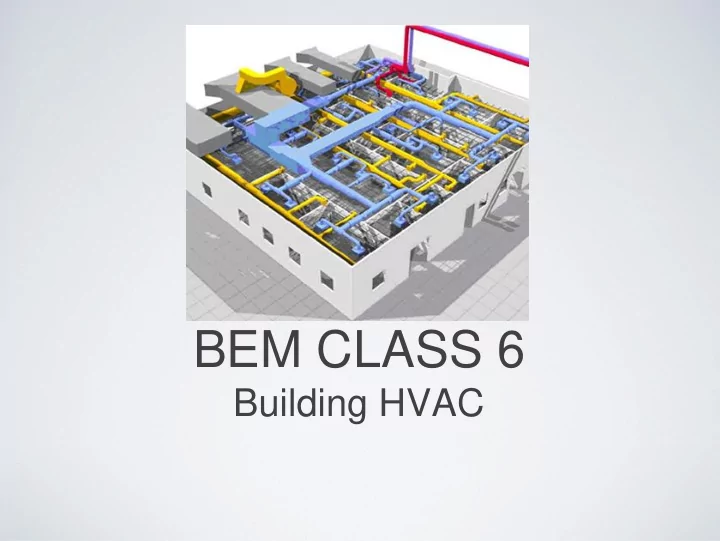

BEM CLASS 6 Building HVAC
Role of HVAC Equipment To maintain a comfortable and healthy indoor environment for occupants by controlling the • Temperature • Moisture Content (humidity) • Air Quality • Air Circulation
Goals Gain an understanding of: • Different Types of Space Conditioning Systems • Various System Components • General Characteristics About How They Operate
HVAC System Types HVAC systems are categorized by the method used to convey energy 1. Direct refrigerant systems (DX) 2. All-air systems 3. Air-and-water systems 4. All-water systems
Direct-expansion (DX) refrigerant systems Example: Window AC • Refrigerant absorbs heat Vapor Compression Cycle from a room Changes from liquid to gas • The gas is compressed and moves to the Condenser • In the Condenser, heat is rejected to the environment and allowed to expand and change from gas back to a liquid • The cycle repeats until the room is cooled to the desired set point
Direct-expansion (DX) refrigerant systems These “unitary systems” are very common in residential buildings New York City. They Require no distribution network (ducts) By their nature, they are individually controlled and not connected to other building operations. Though not used in Modern Commercial buildings the core cooling process (DX vapor compression cooling cycle) is used in more sophisticated air-handling applications, heat pump systems and large chillers.
All-air systems • Air is the only heat transfer medium used between the mechanical system and the zone(s) it serves. Single-duct Constant volume Multi-zone, variable-air volume (VAV) Multi-zone with re-heat Dual-duct systems also possible but uncommon
All-Air Systems: Overview • Provides all sensible and latent cooling, preheating, and humidification required by the zone(s) • Additional cooling or humidification at the zone rare (industrial systems) • Heating is either provided by the main air stream by the central system (AHU) or locally at a specific zone (Reheat) • Classified into single- and dual-duct categories as well as constant and variable volume categories • Conditioning depends on air mass flow rate and temperature (enthalpy) difference between supply and room air 8
Single-Duct Systems • Main heating and cooling coils in series arrangement • Ducts supply air to all terminals at a common temperature • Capacity varied by varying temperature or flow rate • Types of single-duct systems • Constant Volume Single zone Multiple-zone reheat Bypass VAV • Variable Air Volume (VAV) Throttling Fan-powered Reheat Induction Variable diffusers 9
Dual-Duct Systems • Main heating and cooling coils in parallel • May use separate warm and cold air duct distribution systems, blending air at the terminal device • May blend air near the main unit and have separate duct for each zone • Most vary supply temperature, limited number (around 1% of all installed systems?) vary flow rate • Types of dual-duct systems Single zone (“dual duct”) Constant volume Variable air volume Dual conduit Multizone Constant volume Variable air volume Three-deck multizone 10
All-air systems • This class of system is extremely versatile • Components Include • Fans (Supply/Return) (Constant/Variable) • Heating Element (furnace, heat pump, hot water coil) • Cooling Element (DX coil, heat pump, chilled water coil) • Control sensors, allow for air-side economizing, temperature resets, energy recovery • VAV applications allow for thermal control of multiple zones
All-air system: Air handling unit
VAVSystems • Objective: reduce flow rate when loads are not as high to save fan energy (fan energy proportional to flow rate cubed ) • Especially effective for perimeter zones that may receive solar heating • Temperature is maintain same for all zones, flow rate varied to each • Flow rate bounded at lower end by a minimum air fraction • Concern 1: indoor air quality — outside air may limit lower bound of VAV flow rate • Concern 2: humidity — it may also limit lower bound of VAV flow rate • Terminal devices used to further reduce cooling or to provide heating • From maximum cooling point, VAV first throttles back flow and then adds reheat (or uses terminal device) 13
Air and water Systems • Majority of space heating/cooling is accomplished via the water distribution network. Ventilation is handled separately and only a “Primary” stream of outside air is supplied to the space. • Potential for heating without the circulation of air (unoccupied periods, similar to baseboard heating) • Main categories/arrangements • Fan-coil units • Induction units • Two-, Three-, and Four-Pipe arrangements • Packaged Terminal AC (PTAC) units
Air and water Systems
All-water systems • These systems only heat and cool • Air quality and ventilation are either handled by other systems or by fresh air from infiltration • Typically located in non-regularly occupied spaces. • Garages • Vestibules • IDF rooms
Heating Equipment Electric resistance heating Heat pump in heating mode Solar panels Boiler Water same basic principle, just a different fluid Steam Furnace (air) 17
Boilers • Recirculate hot water to maintain meet the heating load of the building. Boilers fuels include: Natural Gas #2, #4, #6 Oil Wood Pellets Electricity
Chillers • Recirculates chilled water through the building to meet the cooling load. • Chillers reject their heat to the outside environment either by air exchange (air-cooled) or to cooling towers (water cooled). • Common chillers use compression cooling cycles. Absorption chillers are used when an abundant source of waste heat exists
Compression Cycle: Chilled Water Direction of heat transfer Cooling Tower Compressor Condenser Expansion Valve Evaporator Air System To Zones… Cooling Coil 20
Efficiency Characteristics
Recommend
More recommend